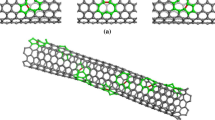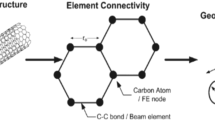Abstract
Molecular dynamics simulations with Adaptive Intermolecular Reactive Empirical Bond Order force fields were conducted to determine the transversely isotropic elastic properties of carbon nanotubes (CNTs) containing vacancies. This is achieved by imposing axial extension, twist, in-plane biaxial tension, and in-plane shear to the defective CNTs. The effects of vacancy concentrations, their position, and the diameter of armchair CNTs were taken into consideration. Current results reveal that vacancy defects affect (i) the axial Young’s and shear moduli of smaller-diameter CNTs more than the larger ones and decrease by 8 and 16% for 1 and 2% vacancy concentrations, respectively; (ii) the plane strain bulk and the in-plane shear moduli of the larger-diameter CNTs more profoundly, reduced by 33 and 45% for 1 and 2% vacancy concentrations, respectively; and (iii) the plane strain bulk and in-plane shear moduli among all the elastic coefficients. It is also revealed that the position of vacancies along the length of CNTs is the main influencing factor which governs the change in the properties of CNTs, especially for vacancy concentration of 1%. The current fundamental study highlights the important role played by vacancy defected CNTs in determining their mechanical behaviors as reinforcements in multifunctional nanocomposites.
Similar content being viewed by others
References
Treacy, M.M.J., Ebbesen, T.W., Gibson, J.M.: Exceptionally high Young’s modulus observed for individual carbon nanotubes. Nature 381, 678–680 (1996). https://doi.org/10.1038/381678a0
Shen, L., Li, J.: Transversely isotropic elastic properties of single-walled carbon nanotubes. Phys. Rev. B. 69, 045414 (2004). https://doi.org/10.1103/PhysRevB.69.045414
Shen, L., Li, J.: Transversely isotropic elastic properties of multiwalled carbon nanotubes. Phys. Rev. B. 71, 035412 (2005). https://doi.org/10.1103/PhysRevB.71.035412
Al-Ostaz, A., Pal, G., Mantena, P.R., Cheng, A.: Molecular dynamics simulation of SWCNT-polymer nanocomposite and its constituents. J. Mater. Sci. 43, 164–173 (2008). https://doi.org/10.1007/s10853-007-2132-6
Song, X., Ge, Q., Yen, S.-C.: A first-principles study on the elastic properties of single-walled carbon nanotubes. Proc. Inst. Mech. Eng. Part N J. Nanoeng. Nanosyst. 223, 163–168 (2010). https://doi.org/10.1177/17403499JNN181
Tsai, J.-L., Tzeng, S.-H., Chiu, Y.-T.: Characterizing elastic properties of carbon nanotubes/polyimide nanocomposites using multi-scale simulation. Compos. Part B Eng. 41, 106–115 (2010). https://doi.org/10.1016/j.compositesb.2009.06.003
Faria, B., Silvestre, N., Canongia, J.N.: Mechanical behaviour of carbon nanotubes under combined twisting-bending. Mech. Res. Commun. 73, 19–24 (2016). https://doi.org/10.1016/j.mechrescom.2016.01.010
Ajayan, P.M., Ravikumar, V., Charlier, J.-C.: Surface reconstructions and dimensional changes in single-walled carbon nanotubes. Phys. Rev. Lett. 81, 1437–1440 (1998). https://doi.org/10.1103/PhysRevLett.81.1437
Belytschko, T., Xiao, S.P., Schatz, G.C., Ruoff, R.S.: Atomistic simulations of nanotube fracture. Phys. Rev. B. 65, 235430 (2002). https://doi.org/10.1103/PhysRevB.65.235430
Troya, D., Mielke, S.L., Schatz, G.C.: Carbon nanotube fracture—differences between quantum mechanical mechanisms and those of empirical potentials. Chem. Phys. Lett. 382, 133–141 (2003). https://doi.org/10.1016/j.cplett.2003.10.068
Lu, A.J., Pan, B.C.: Nature of single vacancy in achiral carbon nanotubes. Phys. Rev. Lett. 92, 105504 (2004). https://doi.org/10.1103/PhysRevLett.92.105504
Hao, X., Qiang, H., Xiaohu, Y.: Buckling of defective single-walled and double-walled carbon nanotubes under axial compression by molecular dynamics simulation. Compos. Sci. Technol. 68, 1809–1814 (2008). https://doi.org/10.1016/j.compscitech.2008.01.013
Yuan, J., Liew, K.M.: Effects of vacancy defect reconstruction on the elastic properties of carbon nanotubes. Carbon 47, 1526–1533 (2009). https://doi.org/10.1016/j.carbon.2009.01.048
Chen, L., Zhao, Q., Gong, Z., Zhang, H.: The effects of different defects on the elastic constants of single-walled carbon nanotubes. In: Proceedings of the IEEE international conference on Nano/Micro engineered molecular systems (2010). https://doi.org/10.1109/NEMS.2010.5592271
Fefey, E.G., Mohan, R., Kelkar, A.: Computational study of the effect of carbon vacancy defects on the Young’s modulus of (6, 6) single wall carbon nanotube. Mater. Sci. Eng. B. 176, 693–700 (2011). https://doi.org/10.1016/j.mseb.2011.02.019
Ghavamian, A., Rahmandoust, M., Öchsner, A.: A numerical evaluation of the influence of defects on the elastic modulus of single and multi-walled carbon nanotubes. Comput. Mater. Sci. 62, 110–116 (2012). https://doi.org/10.1016/j.commatsci.2012.05.003
Talukdar, K., Mitra, A.K.: Molecular dynamics simulation of elastic properties and fracture behavior of single wall carbon nanotubes with vacancy and Stone–Wales defect. Adv. Compos. Mater. 20, 29–38 (2011). https://doi.org/10.1163/092430410X504189
Sharma, K., Saxena, K.K., Shukla, M.: Effect of multiple Stone-Wales and vacancy defects on the mechanical behavior of carbon nanotubes using molecular dynamics. Procedia Eng. 38, 3373–3380 (2012). https://doi.org/10.1016/j.proeng.2012.06.390
Zhou, Z.R., Liao, K.: Effect of inter-defect interaction on tensile fatigue behavior of a single-walled carbon nanotube with Stone–Wales defects. J. Appl. Mech. 80, 051005 (2013). https://doi.org/10.1115/1.402353
Rafiee, R., Pourazizi, R.: Evaluating the influence of defects on the Young’ s modulus of carbon nanotubes using stochastic modeling. Mater. Res. 17, 758–766 (2014). https://doi.org/10.1590/S1516-14392014005000071
Sakharova, N.A., Pereira, A.F.G., Antunes, J.M., Fernandes, J.V.: Numerical simulation study of the elastic properties of single-walled carbon nanotubes containing vacancy defects. Compos. Part B Eng. 89, 155–168 (2016). https://doi.org/10.1016/j.compositesb.2015.11.029
Alian, A.R., Meguid, S.A., Kundalwal, S.I.: Unraveling the influence of grain boundaries on the mechanical properties of polycrystalline carbon nanotubes. Carbon 125, 180–188 (2017). https://doi.org/10.1016/J.CARBON.2017.09.056
Bocko, J., Lengvarský, P.: Buckling of single-walled carbon nanotubes with and without defects. J. Mech. Sci. Technol. 31, 1825–1833 (2017). https://doi.org/10.1007/s12206-017-0330-y
Shahini, E., Karimi Taheri, K., Karimi Taheri, A.: An investigation on tensile properties of coiled carbon nanotubes using molecular dynamics simulation. Diam. Relat. Mater. 74, 154–163 (2017). https://doi.org/10.1016/j.diamond.2017.02.023
Joshi, U.A., Sharma, S.C., Harsha, S.P.: Effect of pinhole defects on the elasticity of carbon nanotube based nanocomposites. J. Nanotechnol. Eng. Med. 2, 11003 (2011). https://doi.org/10.1115/1.4003028
Yang, S., Yu, S., Cho, M.: Influence of Thrower–Stone–Wales defects on the interfacial properties of carbon nanotube/polypropylene composites by a molecular dynamics approach. Carbon 55, 133–143 (2013). https://doi.org/10.1016/j.carbon.2012.12.019
Sharma, S., Chandra, R., Kumar, P., Kumar, N.: Effect of Stone–Wales and vacancy defects on elastic moduli of carbon nanotubes and their composites using molecular dynamics simulation. Comput. Mater. Sci. 86, 1–8 (2014). https://doi.org/10.1016/j.commatsci.2014.01.035
Mahboob, M., Zahabul Islam, M.: Molecular dynamics simulations of defective CNT-polyethylene composite systems. Comput. Mater. Sci. 79, 223–229 (2013). https://doi.org/10.1016/j.commatsci.2013.05.042
Lv, Q., Wang, Z., Chen, S., Li, C., Sun, S., Hu, S.: Effects of single adatom and Stone–Wales defects on the elastic properties of carbon nanotube/polypropylene composites: a molecular simulation study. Int. J. Mech. Sci. 131–132, 527–534 (2017). https://doi.org/10.1016/j.ijmecsci.2017.08.001
Kumar, A., Singh, P.K., Sharma, K., Dwivedi, V.K.: Evaluation of elastic moduli for different patterns of Stone–Thrower–Wales defect in carbon nanotubes/epoxy composites. Mater. Today Proc. 4, 9423–9428 (2017). https://doi.org/10.1016/j.matpr.2017.06.197
Kundalwal, S.I., Ray, M.C.: Effective properties of a novel composite reinforced with short carbon fibers and radially aligned carbon nanotubes. Mech. Mater. 53, 47–60 (2012). https://doi.org/10.1016/j.mechmat.2012.05.008
Liu, X., Yang, Q.-S., He, X.-Q., Liew, K.-M.: Cohesive laws for van der Waals interactions of super carbon nanotube/polymer composites. Mech. Res. Commun. 72, 33–40 (2016). https://doi.org/10.1016/j.mechrescom.2015.12.004
Kundalwal, S.I., Suresh Kumar, R., Ray, M.C.: Effective thermal conductivities of a novel fuzzy fiber-reinforced composite containing wavy carbon nanotubes. J. Heat Transf. 137, 012401 (2015). https://doi.org/10.1115/1.4028762
Choyal, V., Kundalwal, S.I.: Interfacial characteristics of hybrid nanocomposite under thermomechanical loading. J. Mech. Behav. Mater. 26, 95–103 (2017)
Mielke, S.L., Troya, D., Zhang, S., Li, J.L., Xiao, S., Car, R., Ruoff, R.S., Schatz, G.C., Belytschko, T.: The role of vacancy defects and holes in the fracture of carbon nanotubes. Chem. Phys. Lett. 390, 413–420 (2004). https://doi.org/10.1016/j.cplett.2004.04.054
Sammalkorpi, M., Krasheninnikov, A., Kuronen, A., Nordlund, K., Kaski, K.: Mechanical properties of carbon nanotubes with vacancies and related defects. Phys. Rev. B 70, 245416 (2004). https://doi.org/10.1103/PhysRevB.70.245416
Haskins, R.W., Maier, R.S., Ebeling, R.M., Marsh, C.P., Majure, D.L., Bednar, A.J., Welch, C.R., Barker, B.C., Wu, D.T.: Tight-binding molecular dynamics study of the role of defects on carbon nanotube moduli and failure. J. Chem. Phys. (2007). https://doi.org/10.1063/1.2756832
Ho, T., Rai, P., Xie, J., Varadan, V.K., Hestekin, J.A.: Stable flexible electrodes with enzyme cluster decorated carbon nanotubes for glucose-driven power source in biosensing applications. J. Nanotechnol. Eng. Med. 1, 041013 (2010). https://doi.org/10.1115/1.4002731
Zhang, Y., Bai, Y., Yan, B.: Functionalized carbon nanotubes for potential medicinal applications. Drug Discov. Today 15, 428–435 (2010). https://doi.org/10.1016/j.drudis.2010.04.005
Plimpton, S.: Fast parallel algorithms for short-range molecular dynamics. J. Comput. Phys. 117, 1–19 (1995). https://doi.org/10.1006/jcph.1995.1039
Stuart, S.J., Tutein, A.B., Harrison, J.A.: A reactive potential for hydrocarbons with intermolecular interactions. J. Chem. Phys. 112, 6472–6486 (2000). https://doi.org/10.1063/1.481208
Ansari, R., Rouhi, H., Nasiri Rad, A.: Vibrational analysis of carbon nanocones under different boundary conditions: an analytical approach. Mech. Res. Commun. 56, 130–135 (2014). https://doi.org/10.1016/j.mechrescom.2013.12.010
Krasheninnikov, A.V., Nordlund, K.: Irradiation effects in carbon nanotubes. Nucl. Instrum. Methods Phys. Res. Sect. B 216, 355–366 (2004). https://doi.org/10.1016/j.nimb.2003.11.061
Haghighatpanah, S., Bolton, K.: Molecular-level computational studies of single wall carbon nanotube polyethylene composites. Comput. Mater. Sci. 69, 443–454 (2013). https://doi.org/10.1016/j.commatsci.2012.12.012
Alian, A.R., Kundalwal, S.I., Meguid, S.A.: Multiscale modeling of carbon nanotube epoxy composites. Polymer 70, 149–160 (2015). https://doi.org/10.1016/j.polymer.2015.06.004
Chang, T., Gao, H.: Size-dependent elastic properties of a single-walled carbon nanotube via a molecular mechanics model. J. Mech. Phys. Solids 51, 1059–1074 (2003). https://doi.org/10.1016/S0022-5096(03)00006-1
Xiao, J.R., Gama, B.A., Gillespie, J.W.: An analytical molecular structural mechanics model for the mechanical properties of carbon nanotubes. Int. J. Solids Struct. 42, 3075–3092 (2005). https://doi.org/10.1016/j.ijsolstr.2004.10.031
Hashin, Z., Rosen, B.W.: The elastic moduli of fiber-reinforced materials. J. Appl. Mech. 31, 223–232 (1964). https://doi.org/10.1115/1.3629590
Hung, N.T., Truong, D.V., Thanh, V.V., Saito, R.: Intrinsic strength and failure behaviors of ultra-small single-walled carbon nanotubes. Comput. Mater. Sci. 114, 167–171 (2016). https://doi.org/10.1016/j.commatsci.2015.12.036
Author information
Authors and Affiliations
Corresponding author
Rights and permissions
About this article
Cite this article
Kundalwal, S.I., Choyal, V. Transversely isotropic elastic properties of carbon nanotubes containing vacancy defects using MD. Acta Mech 229, 2571–2584 (2018). https://doi.org/10.1007/s00707-018-2123-5
Received:
Revised:
Published:
Issue Date:
DOI: https://doi.org/10.1007/s00707-018-2123-5




